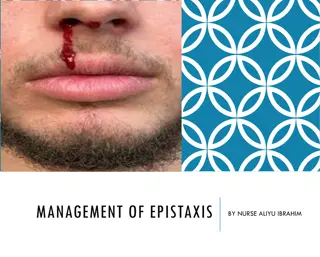fibroids-and-fertility-what-you-need-to-know-
Worried about fibroids impacting your baby\u2019s dreams? Millions of women face the challenging reality of uterine fibroids. Female factor infertility can occur due to many reasons. It is highly important to regularly observe one\u2019s reproductive health. Many women of young age have issues relat
1 views • 6 slides
Gynecological Considerations for Long-Duration Spaceflight
This study by the National Aeronautics and Space Administration (NASA) discusses the potential effects of microgravity and space radiation on gynecological health during long-duration spaceflight. Topics covered include normal menstruation, fertility, gynecologic pathology, and the impact of hormona
0 views • 28 slides
Ticagrelor Monotherapy vs. 12-Month Dual Anti-Platelet Therapy After Coronary Stent Implantation for ACS
The study compares the efficacy of ticagrelor monotherapy after less than 1 month of dual anti-platelet therapy (DAPT) to 12-month ticagrelor-based DAPT in patients with acute coronary syndrome (ACS) undergoing percutaneous coronary intervention (PCI) with drug-eluting stent implantation. The aim is
1 views • 19 slides
Risks and Strategies for Safe Caesarean Deliveries in South Africa
Understanding the mortality burden related to caesarean deliveries (CD) in South Africa, this report highlights the need for safe CD practices amidst high maternal death rates. Factors influencing safe CD, checklists for accreditation, and strategies for action plans are discussed. The Case Fatality
0 views • 40 slides
Essential First Aid Quiz Questions and Answers
Test your knowledge of first aid procedures with these quiz questions covering topics such as initial steps at an incident, assessing casualties, DR ABC acronym, treatment of burns, bleeding management, and the main aim of giving first aid. Learn important facts and misconceptions about providing pr
2 views • 26 slides
Understanding Bleeding Time and Coagulation Time Tests
The Bleeding Time (BT) test evaluates platelet plug formation and capillary integrity, crucial for surgery preparations. Prolonged bleeding times indicate low platelet count or dysfunction. The Duke method is one way to determine Bleeding Time. Sources of error, such as medication interference, impr
5 views • 8 slides
Understanding Patient Blood Management and Guidelines
Patient Blood Management focuses on optimizing a patient's own blood to avoid unnecessary transfusions through three pillars: optimizing tolerance of anemia, blood volume, and minimizing blood loss. Guidelines and recommendations are developed based on systematic reviews of evidence to improve clini
6 views • 18 slides
Understanding Heavy Menstrual Bleeding: A Comprehensive Overview
A detailed exploration of heavy menstrual bleeding (HMB) by Consultant Gynaecologist Mary Connor, highlighting its impact on women's health and well-being. The importance of early investigations, treatments, and referrals, as well as key considerations for women with obesity or estrogen imbalances.
4 views • 34 slides
Comprehensive Guide to Epistaxis Management by Nurse Aliyu Ibrahim
Bleeding from the nose, known as epistaxis, can stem from various factors and regions within the nasal cavity. Understanding the epidemiology, anatomy, and blood supply of the nose is essential for effective management. This guide delves into the causes, symptoms, classification, diagnostic evaluati
0 views • 24 slides
Understanding Blood Groups, Clotting Time, and Bleeding Time in Medical Practice
This informative material delves into the significance of determining blood groups, clotting time, and bleeding time in medical settings. From explaining the ABO and Rhesus systems to outlining the practical objectives and procedures for the assessments, this resource aims to enhance understanding o
0 views • 34 slides
Understanding Common Labor Complications and Management Options
Labor and birth processes are typically straightforward, but complications can arise, such as failure to progress, fetal distress, excessive bleeding, malposition, prolapsed umbilical cord, cephalopelvic disproportion, and uterine rupture. Management strategies include rupturing membranes, pain reli
1 views • 24 slides
Understanding Uterine Cancer and Postmenopausal Bleeding
Dr. Khalid Akkour, Assistant Professor of Gynecologic Oncology at King Saud University Medical City, provides insights on uterine cancer and postmenopausal bleeding. The structured OSCE discusses important aspects such as taking a focused history, age, ethnicity, past gynecologic and obstetric histo
0 views • 154 slides
Understanding Gestational Trophoblastic Disease: Hydatidiform Mole & Choriocarcinoma
Gestational trophoblastic disease encompasses hydatidiform mole, invasive mole, and choriocarcinoma. This condition involves abnormal fertilization of the oocyte, resulting in various presentations including abnormal growth of the uterus, severe nausea, vaginal bleeding, and symptoms resembling hype
1 views • 9 slides
TCCC Critical Decision Case Studies: Bleeding Management Scenario
This presentation focuses on a critical decision case study in Tactical Combat Casualty Care (TCCC) involving a casualty with high amputations and ongoing massive hemorrhage. The scenario explores the challenges of managing uncontrolled bleeding in a combat situation and provides insights into the r
0 views • 139 slides
Understanding Uterine Leiomyosarcoma: A Case Presentation
A 58-year-old female with a history of fibroids presented with post-menopausal bleeding and was diagnosed with uterine leiomyosarcoma, a rare and aggressive malignancy of uterine smooth muscle cells. The case details the clinical course, diagnosis, and prognosis of this condition, emphasizing the im
0 views • 17 slides
Bleeding Risk Estimation and New BARC Definition Overview
This presentation discusses the significance of bleeding as a clinical endpoint in the context of antithrombotic therapy, emphasizing the association between increased bleeding risk and adverse clinical outcomes. It explores hypothetical mechanisms linking bleeding events to mortality and the constr
1 views • 20 slides
Emergency Management of Massive Blood Loss: A Case Study
This case study details the emergency management of a 72-year-old female patient with massive blood loss due to esophageal varices, providing insights into assessment, resuscitation, and treatment strategies to stop bleeding, replace losses, and prevent worsening. Key considerations include the prin
0 views • 31 slides
Understanding Endometrial Cancer: Risk Factors, Diagnosis, and Management
Endometrial cancer, the most common gynecological malignancy in women, presents with abnormal uterine bleeding and affects women mainly during menopause. Risk factors include hormonal stimulation and estrogen levels. Differentiating between types of endometrial cancer can impact treatment decisions.
3 views • 31 slides
Large Submucous Pedunculated Myomatous Polyp with Chronic Partial Uterine Inversion
A 41-year-old female presented with complaints of bleeding, foul-smelling discharge, abdominal pain, and a mass protruding from the vagina. History revealed menorrhagia, dysmenorrhea, and recent onset symptoms. Physical examination showed no significant abnormalities except for a firm palpable uteru
1 views • 19 slides
Life-saving Intervention with Celox: Real-life Examples and Success Stories
Learn about the life-saving impact of Celox in critical situations such as life-threatening bleeding, blast injuries, and gunshot wounds. Real-life cases highlight how Celox effectively stops bleeding, stabilizes patients, and enables transfer to hospitals, showcasing its crucial role in emergency m
0 views • 33 slides
Treatment Strategies for Hemorrhagic Stroke: Goals and Management
Short-term goals for treating hemorrhagic stroke involve rapid neurointensive care to maintain adequate oxygenation, breathing, and circulation, along with managing increased intracranial pressure and blood pressure. Long-term management focuses on preventing complications, recurrent bleeding, delay
11 views • 9 slides
Evaluation of Risk Stratification Schemes for Ischaemic Stroke and Bleeding in Atrial Fibrillation Patients
A study conducted in Sweden on 182,678 patients with atrial fibrillation aimed to investigate risk factors for stroke and bleeding. The research assessed the application of CHA2DS2-VASc and HAS-BLED schemes for stroke and bleeding risk evaluations. Data from the Swedish Atrial Fibrillation cohort st
0 views • 20 slides
Comparing Bleeding and Mortality Risks of Dabigatran vs. Rivaroxaban in Elderly Medicare Beneficiaries
A study by DJ Graham et al. compared the risks of stroke, bleeding, and mortality in elderly Medicare beneficiaries with nonvalvular atrial fibrillation treated with dabigatran or rivaroxaban. The study included over 118,000 patients and found that dabigatran was associated with a lower risk of majo
0 views • 9 slides
Tactical Field Care - Shock Recognition and Management
Tactical Field Care emphasizes the importance of shock recognition and prompt intervention to prevent casualties on the battlefield. Understanding the signs, symptoms, and management steps of shock, particularly in trauma cases with life-threatening bleeding, is crucial for medical personnel. This m
0 views • 18 slides
Tactical Field Medical Assistant Training - Fractures Assessment and Management
Explore the Tactical Field Medical Assistant Course training modules focusing on fractures assessment and management. Learn to identify fracture warning signs, differentiate between closed and open fractures, and demonstrate proper splint application. Gain knowledge on caring for fractures in tactic
1 views • 19 slides
First Aid Tips for Common Trauma Injuries
Learn how to manage various trauma injuries such as skull fractures, eye injuries, blowout fractures, epistaxis, mouth injuries, soft tissue injuries, open injuries, and penetrating wounds with practical first aid techniques. From treating bleeding and impaled objects to saving dislodged teeth and c
0 views • 16 slides
Clinical and Laboratory Features of Radical Total Gastrectomy: Early Outcomes
Assessing the clinical and laboratory features, as well as the early outcomes following radical total gastrectomy is crucial in the management of gastric cancer. This study conducted at Hanoi Oncology Hospital retrospectively analyzed 43 patients who underwent this procedure. The overview includes d
0 views • 27 slides
Understanding Epistaxis: Causes, Sites of Bleeding, and Management
Epistaxis, commonly known as nosebleed, can range from trivial to life-threatening. It can result from various local and general causes, including idiopathic bleeds, trauma, inflammatory conditions, neoplastic growths, and systemic diseases. Understanding the vascular anatomy and sites of bleeding i
0 views • 23 slides
Overview of Stomach Surgery and Treatment Options
The stomach plays a crucial role in digestion and is divided into four regions - cardia, fundus, body, and pyloric part. Understanding the anatomy of the stomach is essential for surgical interventions, including treatment for benign and malignant gastric diseases like peptic ulcer disease. Surgical
0 views • 30 slides
Comprehensive Guide to Abnormal Uterine Bleeding: Causes, Approach, and Management
Explore the approach to abnormal uterine bleeding in general practice with Dr. Lubna Qayam. Dive into different scenarios of patients presenting with varied symptoms and histories. Learn about the causes of abnormal uterine bleeding in reproductive age and post-menopausal women, including anovulator
0 views • 22 slides
Ticagrelor Monotherapy vs. Ticagrelor + Aspirin in High-Risk PCI Patients: TWILIGHT-COMPLEX Study
Patients undergoing complex PCI are at high risk of ischemic events. The TWILIGHT-COMPLEX study aims to compare the safety and efficacy of ticagrelor monotherapy versus ticagrelor with aspirin in patients who completed 3 months of DAPT post-PCI. While extended DAPT may reduce ischemic events, it als
0 views • 27 slides
Procedures in Chronic Liver Disease Patients During COVID-19
COVID-19 poses challenges to healthcare services, requiring a balance between minimizing viral spread and providing quality care. Endoscopy in chronic liver disease patients must consider SARS-CoV-2 transmission risks. Specific procedures like endoscopic band ligation and ERCP are indicated based on
0 views • 6 slides
Management of Lower GI Bleeding: Initial Evaluation and Resuscitation
Lower gastrointestinal bleeding, originating distal to the ligament of Treitz, often presents with overt or occult symptoms. Initial management involves hemodynamic stabilization, localization of the bleed site, and tailored therapeutic interventions. Key steps include IV fluid resuscitation, monito
0 views • 44 slides
Overview of Dermatologic Emergencies: Recognition and Management
In this course taught by Prof. Marwan Al Khawajah at King Saud University College of Medicine, the definition of emergencies, alarming morphological patterns, and specific conditions like urticaria, purpura, and bullous diseases are covered. Dermatologic emergencies are acute, unexpected, and danger
0 views • 54 slides
Understanding Portal Hypertension: Causes, Symptoms, and Management
Portal hypertension is a condition characterized by increased pressure in the portal venous system, leading to serious complications like variceal bleeding. This article covers the definition, causes, and classification of portal hypertension. Learn about its manifestations, diagnostic approaches, a
0 views • 24 slides
Case Discussion: Post-Menopausal Bleeding in a 65-year-old Woman
Mrs. Pauline, a 65-year-old woman presenting with post-menopausal bleeding for the past 4 months, without associated symptoms, history of recent weight changes, or hormonal therapy. Her menstrual and obstetric histories, along with past medical and surgical history, are significant. Further evaluati
0 views • 22 slides
Understanding Third Trimester Bleeding: Causes, Evaluation, and Management
Third trimester bleeding can be caused by various factors like placental abruption and previa, requiring prompt evaluation including assessing fetal heart rate and determining placental location. Different complications can arise for both the mother and fetus, necessitating specific management plans
0 views • 17 slides
First Aid for Controlling and Treating Bleeding and Injuries
Learn about how to handle and control bleeding, both internal and external, through first aid techniques including applying pressure bandages, using tourniquets, and recognizing signs of internal and external bleeding. Discover methods to assist victims and provide aid in various situations, such as
1 views • 18 slides
Analysis of Sympathy and Tragedy in 'On the Sidewalk Bleeding' by Evan Hunter
Explore the themes of sympathy, tragedy, and identity in "On the Sidewalk Bleeding" by Evan Hunter through the character of Andy, who struggles with a sense of belonging and recognition after a tragic incident. The essay delves into the societal pressures, personal aspirations, and ultimate fate of
0 views • 71 slides
Emergency Management in Cardiac Intensive Care
Information on managing emergencies in cardiac intensive care including topics like hemorrhage post-cardiac surgery, tamponade post-cardiac surgery, and control of bleeding. Details on initial steps for bleeding control, teamwork in managing hemorrhage, and diagnosing tamponade post-cardiac surgery
0 views • 16 slides







































